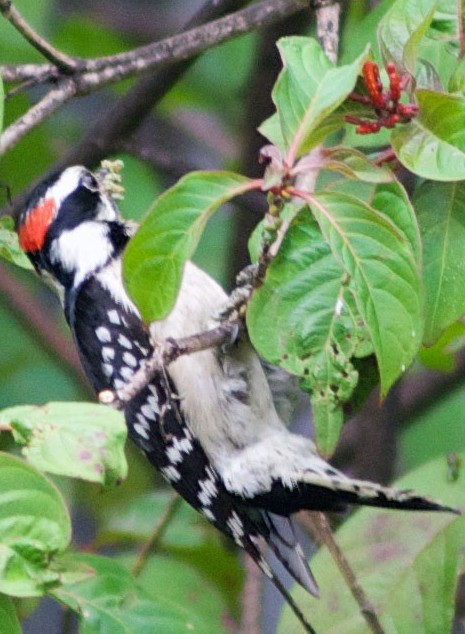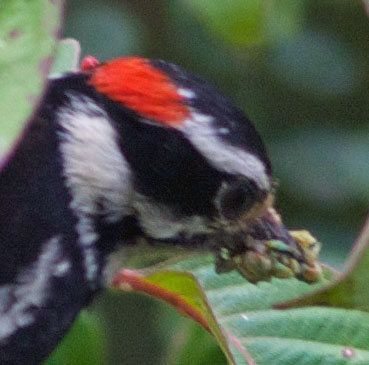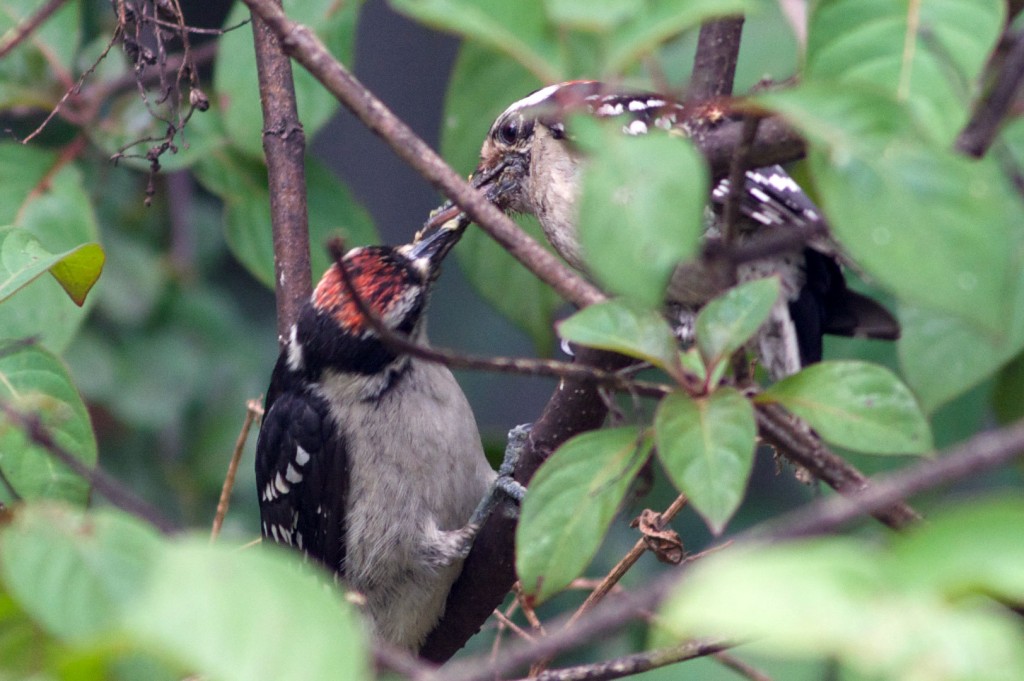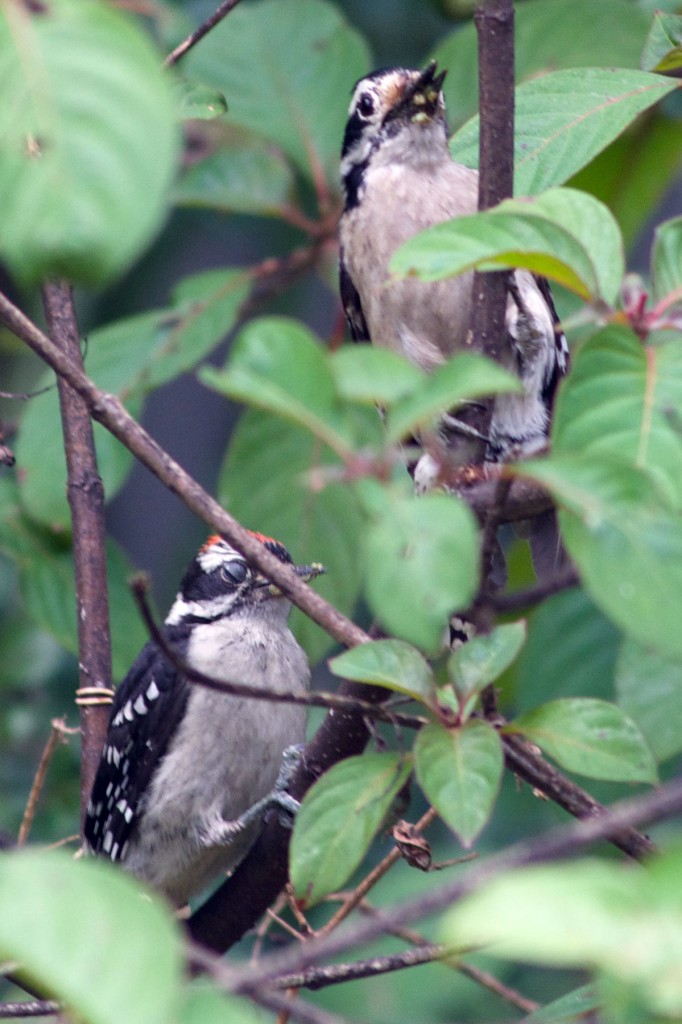From time to time the native plants in my yard, which I do my best to foster, suffer from an overabundance of a certain tiny insect: scale. These insects aren’t scary to most people—they don’t bite, they don’t fly up and startle you, they don’t even move after they hunker down in their chosen spot to feed. But they are rather scary to the plants they parasitize. They latch onto a growing stem, use their piercing sucking mouthparts to penetrate the thin exterior walls, and suck up the vital juices that are supposed to be circulating through the plant and helping it grow. Soft-bodied scale also excrete (yes, excrete, not secrete) honeydew, which, in enough quantity, enables the fungus called sooty mold to grow on the plant. Sooty mold can cover the entire leaf surface, interfering with photosynthesis. So not only do the scale insects steal the plant’s sap (literally sapping its energy), they also create an environment in which other plant pests can interfere with other important plant functions.
You’d think that scale insects would be pretty easy to defeat—after all, they can’t move or sting, and they have no particular defenses at all apart from a waxy covering that prevents casual inspectors from noticing that they exist. Other insects, such as lacewing and lady beetle larvae, like to eat these little guys whenever they find them. But their honeydew buys them some serious protectors: ants. The sweet, nutritious by-product of their all-plant-juice diet is beloved by these social insects. Ant colonies will send out “cowboys” to tend the herd and to bring back their liquid excrement (“milk,” if you will) to the nest. That’s right, ants are scale and aphid ranchers.
I’ve spent the last few weeks out in the garden trying my best to remove these scale insects without damaging the plants, but it’s tough sledding. There are dozens of insects per growing stem, and most of the shrubs and trees in my yard have dozens upon dozens of growing stems. Stripping the bugs off and squishing them makes your fingers sticky and smelly, and there’s always the risk of pinching off the stem or leaf of the plant when you’re just trying to scrape off the sticky gooey bug that’s attacking it.
There are about 175 armored species of this pest in Florida, and 60 “soft” scale species. The biology of the species goes like this, according to the UF/IFAS web page about them:
The armored scale life cycle is generalized as follows. The eggs are laid underneath the waxy covering and hatch over a period of one to three weeks. The newly hatched scales (called crawlers) move about over the plant until they locate succulent new growth. They insert their piercing-sucking mouthparts into the plant and begin feeding. Female scales lose their legs and antennae during the first molt. They molt a second time before reaching maturity and do not pupate. The cast skins (exuviae) are incorporated in the scale cover. Male scales go through two additional molts and pupate underneath the wax. Adult males are tiny two-winged, gnat-likeinsects without mouthparts. In some armored scales the adult stage is reached in six weeks, and there are several generations per year.
In the females of the soft scales the antennae and legs are not lost, but are reduced to such an extent that though the adults can move about somewhat they seldom do. The wax when secreted, usually forms a sac at the rear end of the body enclosing the eggs, and the scale on the back of the insect becomes much thickened, forming a thick fluffy mass. The life cycle is similar to the armored scales except some soft scales require one year to reach maturity.
But sometimes, if you’re lucky, you really can get help from mother nature, in the good old-fashioned food chain sense. And that’s what happened the other day. I was soaking my feet in the pool while making sure my three-year-old stayed in his floatie—he can “swim” really fast in that plastic ring, but he tends to sink if he’s not using it, which is a Bad Thing—when I heard some fast-paced, high-pitched bird calls somewhere nearby. Intrigued, I started checking things out when I discovered to my great astonishment and delight that a pair of Downy Woodpeckers were gleaning insects from the firebushes that were most heavily infested with scale.
Upon further inspection it turned out that this wasn’t a “pair” of woodpeckers so much as it was a parent and a young bird. And what was that dad (male downies have a red patch on the nape of the neck; female birds are white-headed) stuffing down baby bird’s gullet to shut it up? You guessed it: a beak full of scale!

In case it’s hard to see in that shot, here’s a closer look:

How’s that for service? I get to see wildlife in action, and that action consists of helping me out in my gardening endeavors! While it’s too soon for the plants to have regained their showy appearance after their battle with the sap-sucking, soot-making, honeydew cows, it’s encouraging to see that garden ecology sometimes does work.
Here are a few more shots of the birds doing their thing; I tried to stay inconspicuous for fear of frightening them off, but they didn’t seem to mind my being about 20 feet away, hiding behind the kids’ plastic slide and firing away with my zoom lens:


The next morning as I was out, sans camera, inspecting the handiwork (beakywork?) of these fine insect control service technicians, the same pair flew right up into the tree next to those firebushes and began their chipping/begging act again. You can bet I high-tailed it out of there, in hopes that they’d set about polishing off the bugs that survived the previous night’s work.
As it turns out, the woodpeckers appear to be husbanding their food supply rather than eradicating my pest problem, so I still have a lot of bug squishing to do. Oh, well. It’s fun having the birds in the yard, and if I’m out there squishing the scale, at least I’m out and about with a chance to see more urban wildlife!
